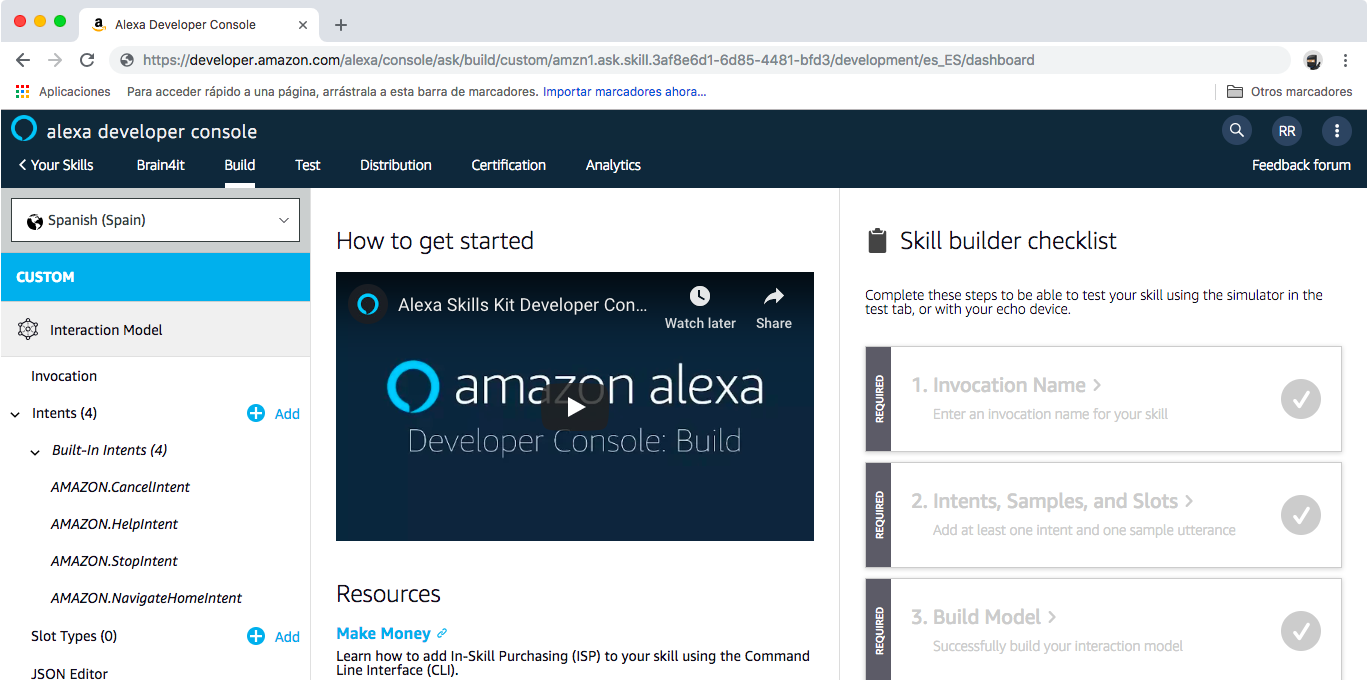Amazon Alexa integration
Introduction
Amazon Alexa is a cloud-connected voice assistant that can be easily programmed to send requests to remote services that perform a variety of tasks such as turning lights on and off, opening doors, reading news or predicting weather.
Alexa usually runs on Amazon Echo smart speakers, but it can also run on smartphones.
To invoke an external service with a voice command it is required to develop a Skill, that is an Alexa application that runs in the Amazon cloud.
In this project we will show how to develop a Skill that invokes actions of a Brain4it module through different voice commands.
Programming the Alexa Skill
To create an Alexa Skill follow the next steps:
- Enter the Alexa developer console with your Amazon account.
- Push the Create Skill button.
- Give the Skill a name, for example "Brain4it" and choose your default language and the Custom model. Finally press the Create Skill button.
- Once the Skill is created, you will enter the programming console.

- Enter the Invocation menu to specify the words that will activate your Skill. Read the note below to know about the invocation name requirements. In this example we choose the words "robot brain". Whenever we say "Alexa, ask robot brain..." our Skill will be invoked.
- Next we must define our custom intents. An intent represents an action that fulfills a user's spoken request. Press the add button on the intents menu. Give the intent a name, for example "sum", and associate one or more utterances to it. An utterance is a sequence of words that will fire the intent. These utterances may have slots, that are like predefined parameters. In this example we add the utterance "sum {number_a} plus {number_b}" where number_a and number_b are slots of type AMAZON.NUMBER. If we say "Ask robot brain sum 4 plus 7", Alexa will send the intent "sum" with slots 4 and 7 to the Brain4it module as a JSON message.
- The last step is to define the URL of the Brain4it service that will process the JSON messages sent by Alexa. Go to Endpoints menu, select HTTPS and enter the URL of the Brain4it external function that will receive the requests. For example: https://www.smarthomedemo.org/brain4it-server-web/modules/alexa/@endpoint. Press Save Endpoints button to save changes.
- Finally, push the Save model and Build model buttons to build your Skill. When the build process finish, your Skill will be ready for testing, but before that we must program the Brain4it module.
Programming the Brain4it module
For each intent Alexa performs an HTTP POST request to our endpoint passing a JSON object that contains the intent name and the values of its slots:
{
"version": "1.0",
"session": {
"new": true,
"sessionId": "amzn1.echo-api.session.0ac9a463-bfe7-4192-9b72-30e3efd25373",
"application": {
"applicationId": "amzn1.ask.skill.7a543b88-f041-4a61-9d60-20a6622393bf"
},
"user": {
"userId": "amzn1.ask.account.AHL5GWE6HXWGHTMLPWSX65WO..."
}
},
"context": {
"System": {
"application": {
"applicationId": "amzn1.ask.skill.7a543b88-f041-4a61-9d60-20a6622393bf"
},
"user": {
"userId": "amzn1.ask.account.AHL5GWE6HXWGHTMLPWSX65W..."
},
"device": {
"deviceId": "amzn1.ask.device.AFUZX7KVT6KT724...",
"supportedInterfaces": {}
},
"apiEndpoint": "https://api.eu.amazonalexa.com",
"apiAccessToken": "eyJ0eXAiOiJKV1QiLCJhb..."
},
"Viewport": {
"experiences": [
{
"arcMinuteWidth": 246,
"arcMinuteHeight": 144,
"canRotate": false,
"canResize": false
}
],
"shape": "RECTANGLE",
"pixelWidth": 1024,
"pixelHeight": 600,
"dpi": 160,
"currentPixelWidth": 1024,
"currentPixelHeight": 600,
"touch": [
"SINGLE"
]
}
},
"request": {
"type": "IntentRequest",
"requestId": "amzn1.echo-api.request.2ef418c7-517f-405a-84b4-163782a9beae",
"timestamp": "2018-12-21T16:41:26Z",
"locale": "en-US",
"intent": {
"name": "add",
"confirmationStatus": "NONE",
"slots": {
"number_a": {
"name": "number_a",
"value": "3",
"confirmationStatus": "NONE",
"source": "USER"
},
"number_b": {
"name": "number_b",
"value": "4",
"confirmationStatus": "NONE",
"source": "USER"
}
}
}
}
}
The endpoint performs the corresponding action and returns a JSON object that may indicate a text to speech:
{
"body": {
"version": "1.0",
"response": {
"outputSpeech": {
"type": "PlainText",
"text": "The result of the operation is 7"
}
}
}
}
So the external function that will process the Alexa requests could be like this:
(function (context json)
(local
response
type
locale
text
intent
intent_func
)
(set message (parse json "format" => "json"))
(set type message/request/type)
(set locale message/request/locale)
(if (not (has MESSAGES locale))
(set locale "en-US")
)
(cond
(when (= type "LaunchRequest")
(set text
(get (get MESSAGES locale) "ready")
)
)
(when (= type "IntentRequest")
(set intent message/request/intent)
(set intent_func (get intents intent/name))
(set text (call intent_func intent locale))
)
(when true
(set text
(get (get MESSAGES locale) "unsupported")
)
)
)
(set context/response-headers
("content-type" => "application/json")
)
(set response
(list
"version" => "1.0"
"response" =>
(list
"outputSpeech" =>
(list "type" => "PlainText" "text" => text)
)
)
)
(string response "format" => "json")
)
For each intent type, a function with the intent name must be declared inside the intents list:
(
"sum" =>
(function (intent locale)
(local number_a number_b)
(set number_a
(number intent/slots/number_a/value)
)
(set number_b
(number intent/slots/number_b/value)
)
(concat
(get (get MESSAGES locale) "sum")
(+ number_a number_b)
)
)
"open_door" =>
(function (intent locale)
(open_door)
(get (get MESSAGES locale) "open_door")
)
...
)
These functions return the text that Alexa will play on the smart speaker.
The sum function adds the values of the number_a and number_b slots and returns a message with the result of this operation.
If we say "Ask robot brain sum 3 plus 4" the sum function will be invoked and Alexa will respond: "The result of this operation is 7."